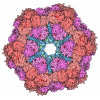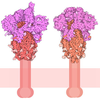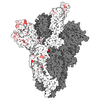+ Open data
Open data
- Basic information
Basic information
| Entry | Database: PDB / ID: 9jcx | ||||||
|---|---|---|---|---|---|---|---|
| Title | Crystal structure of the HCoV-HKU1 RBD and TMPRSS2 | ||||||
 Components Components |
| ||||||
 Keywords Keywords | VIRAL PROTEIN / Complex / Receptor / HCoV-HKU1 | ||||||
| Function / homology |  Function and homology information Function and homology informationtransmembrane protease serine 2 / protein autoprocessing / Attachment and Entry / serine-type peptidase activity / viral translation / Induction of Cell-Cell Fusion / entry receptor-mediated virion attachment to host cell / Attachment and Entry / host cell endoplasmic reticulum-Golgi intermediate compartment membrane / positive regulation of viral entry into host cell ...transmembrane protease serine 2 / protein autoprocessing / Attachment and Entry / serine-type peptidase activity / viral translation / Induction of Cell-Cell Fusion / entry receptor-mediated virion attachment to host cell / Attachment and Entry / host cell endoplasmic reticulum-Golgi intermediate compartment membrane / positive regulation of viral entry into host cell / receptor-mediated virion attachment to host cell / endocytosis involved in viral entry into host cell / fusion of virus membrane with host plasma membrane / serine-type endopeptidase activity / fusion of virus membrane with host endosome membrane / viral envelope / host cell plasma membrane / virion membrane / proteolysis / extracellular exosome / extracellular region / nucleoplasm / membrane / plasma membrane Similarity search - Function | ||||||
| Biological species |  Homo sapiens (human) Homo sapiens (human) Human coronavirus HKU1 Human coronavirus HKU1 | ||||||
| Method |  X-RAY DIFFRACTION / X-RAY DIFFRACTION /  SYNCHROTRON / SYNCHROTRON /  MOLECULAR REPLACEMENT / Resolution: 2.75 Å MOLECULAR REPLACEMENT / Resolution: 2.75 Å | ||||||
 Authors Authors | Wang, H. / Li, M. / Duan, Y. / Yang, H. | ||||||
| Funding support |  China, 1items China, 1items
| ||||||
 Citation Citation |  Journal: Nat Commun / Year: 2025 Journal: Nat Commun / Year: 2025Title: The crystal structure of coronavirus RBD-TMPRSS2 complex provides basis for the discovery of therapeutic antibodies. Authors: Zhao, Z. / Yang, Q. / Liu, X. / Li, M. / Duan, Y. / Du, M. / Zhou, A. / Liu, H. / He, Y. / Wang, W. / Lu, Y. / Zhang, X. / Wang, H. / Yang, X. / Zhang, H. / Chen, X. / Rao, Z. / Yang, H. | ||||||
| History |
|
- Structure visualization
Structure visualization
| Structure viewer | Molecule:  Molmil Molmil Jmol/JSmol Jmol/JSmol |
|---|
- Downloads & links
Downloads & links
- Download
Download
| PDBx/mmCIF format |  9jcx.cif.gz 9jcx.cif.gz | 147.7 KB | Display |  PDBx/mmCIF format PDBx/mmCIF format |
|---|---|---|---|---|
| PDB format |  pdb9jcx.ent.gz pdb9jcx.ent.gz | 109.8 KB | Display |  PDB format PDB format |
| PDBx/mmJSON format |  9jcx.json.gz 9jcx.json.gz | Tree view |  PDBx/mmJSON format PDBx/mmJSON format | |
| Others |  Other downloads Other downloads |
-Validation report
| Summary document |  9jcx_validation.pdf.gz 9jcx_validation.pdf.gz | 466 KB | Display |  wwPDB validaton report wwPDB validaton report |
|---|---|---|---|---|
| Full document |  9jcx_full_validation.pdf.gz 9jcx_full_validation.pdf.gz | 468.6 KB | Display | |
| Data in XML |  9jcx_validation.xml.gz 9jcx_validation.xml.gz | 27.6 KB | Display | |
| Data in CIF |  9jcx_validation.cif.gz 9jcx_validation.cif.gz | 36.1 KB | Display | |
| Arichive directory |  https://data.pdbj.org/pub/pdb/validation_reports/jc/9jcx https://data.pdbj.org/pub/pdb/validation_reports/jc/9jcx ftp://data.pdbj.org/pub/pdb/validation_reports/jc/9jcx ftp://data.pdbj.org/pub/pdb/validation_reports/jc/9jcx | HTTPS FTP |
-Related structure data
| Related structure data |  9jcyC  9jd0C  9jd1C  9u8gC C: citing same article ( |
|---|---|
| Similar structure data | Similarity search - Function & homology  F&H Search F&H Search |
- Links
Links
- Assembly
Assembly
| Deposited unit | 
| ||||||||
|---|---|---|---|---|---|---|---|---|---|
| 1 | 
| ||||||||
| Unit cell |
|
- Components
Components
-Transmembrane protease serine 2 ... , 2 types, 2 molecules AC
| #1: Protein | Mass: 16054.661 Da / Num. of mol.: 1 / Mutation: S250D,S251D,R252D,Q253D, S254K Source method: isolated from a genetically manipulated source Details: We choose the ectodomain of transmembrane protease serine 2 (residues: 109-492) for expression. Residues 250-255 responsible for autocleavage are substituted with DDDDK. The recombinant ...Details: We choose the ectodomain of transmembrane protease serine 2 (residues: 109-492) for expression. Residues 250-255 responsible for autocleavage are substituted with DDDDK. The recombinant protein was cleaved into two chains (A and C) in the purification. Source: (gene. exp.)  Homo sapiens (human) / Gene: TMPRSS2, PRSS10 / Production host: Homo sapiens (human) / Gene: TMPRSS2, PRSS10 / Production host:  |
|---|---|
| #2: Protein | Mass: 27840.742 Da / Num. of mol.: 1 / Mutation: S441A Source method: isolated from a genetically manipulated source Details: We choose the ectodomain of transmembrane protease serine 2 (residues: 109-492) for expression. Residues 250-255 responsible for autocleavage are substituted with DDDDK. The recombinant ...Details: We choose the ectodomain of transmembrane protease serine 2 (residues: 109-492) for expression. Residues 250-255 responsible for autocleavage are substituted with DDDDK. The recombinant protein was cleaved into two chains (A and C) in the purification. Source: (gene. exp.)  Homo sapiens (human) / Gene: TMPRSS2, PRSS10 / Production host: Homo sapiens (human) / Gene: TMPRSS2, PRSS10 / Production host:  |
-Protein / Sugars , 2 types, 4 molecules B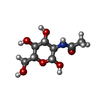

| #3: Protein | Mass: 34275.008 Da / Num. of mol.: 1 Source method: isolated from a genetically manipulated source Details: We choose the segment of spike (residues 323-609) for expression. The recombinant protein encompasses a C-terminal linker ("SGLEVLFQGPGGS") followed by an 8 x His tag. Source: (gene. exp.)  Human coronavirus HKU1 (isolate N1) / Gene: S, 3 / Production host: Human coronavirus HKU1 (isolate N1) / Gene: S, 3 / Production host:  |
|---|---|
| #5: Sugar |
-Non-polymers , 2 types, 25 molecules 
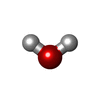

| #4: Chemical | ChemComp-CA / |
|---|---|
| #6: Water | ChemComp-HOH / |
-Details
| Has ligand of interest | N |
|---|---|
| Has protein modification | Y |
-Experimental details
-Experiment
| Experiment | Method:  X-RAY DIFFRACTION / Number of used crystals: 1 X-RAY DIFFRACTION / Number of used crystals: 1 |
|---|
- Sample preparation
Sample preparation
| Crystal | Density Matthews: 3.07 Å3/Da / Density % sol: 59.92 % |
|---|---|
| Crystal grow | Temperature: 293 K / Method: evaporation Details: 0.2 M Tris pH 7.0, 0.2 M MgCl2, 10% (w/v) Polyethylene glycol 8,000 |
-Data collection
| Diffraction | Mean temperature: 100 K / Serial crystal experiment: N | ||||||||||||||||||||||||||||||||||||||||
|---|---|---|---|---|---|---|---|---|---|---|---|---|---|---|---|---|---|---|---|---|---|---|---|---|---|---|---|---|---|---|---|---|---|---|---|---|---|---|---|---|---|
| Diffraction source | Source:  SYNCHROTRON / Site: SYNCHROTRON / Site:  SSRF SSRF  / Beamline: BL02U1 / Wavelength: 0.97918 Å / Beamline: BL02U1 / Wavelength: 0.97918 Å | ||||||||||||||||||||||||||||||||||||||||
| Detector | Type: DECTRIS EIGER2 S 9M / Detector: PIXEL / Date: May 19, 2024 | ||||||||||||||||||||||||||||||||||||||||
| Radiation | Protocol: SINGLE WAVELENGTH / Monochromatic (M) / Laue (L): M / Scattering type: x-ray | ||||||||||||||||||||||||||||||||||||||||
| Radiation wavelength | Wavelength: 0.97918 Å / Relative weight: 1 | ||||||||||||||||||||||||||||||||||||||||
| Reflection | Resolution: 2.75→19.95 Å / Num. obs: 25815 / % possible obs: 99.6 % / Redundancy: 13.27 % / CC1/2: 0.998 / Net I/σ(I): 15.24 | ||||||||||||||||||||||||||||||||||||||||
| Reflection shell |
|
- Processing
Processing
| Software |
| ||||||||||||||||||||||||||||||||||||||||||||||||||||||||||||||||||||||
|---|---|---|---|---|---|---|---|---|---|---|---|---|---|---|---|---|---|---|---|---|---|---|---|---|---|---|---|---|---|---|---|---|---|---|---|---|---|---|---|---|---|---|---|---|---|---|---|---|---|---|---|---|---|---|---|---|---|---|---|---|---|---|---|---|---|---|---|---|---|---|---|
| Refinement | Method to determine structure:  MOLECULAR REPLACEMENT / Resolution: 2.75→19.95 Å / SU ML: 0.34 / Cross valid method: FREE R-VALUE / σ(F): 1.36 / Phase error: 27.21 / Stereochemistry target values: ML MOLECULAR REPLACEMENT / Resolution: 2.75→19.95 Å / SU ML: 0.34 / Cross valid method: FREE R-VALUE / σ(F): 1.36 / Phase error: 27.21 / Stereochemistry target values: ML
| ||||||||||||||||||||||||||||||||||||||||||||||||||||||||||||||||||||||
| Solvent computation | Shrinkage radii: 0.9 Å / VDW probe radii: 1.1 Å / Solvent model: FLAT BULK SOLVENT MODEL | ||||||||||||||||||||||||||||||||||||||||||||||||||||||||||||||||||||||
| Refinement step | Cycle: LAST / Resolution: 2.75→19.95 Å
| ||||||||||||||||||||||||||||||||||||||||||||||||||||||||||||||||||||||
| Refine LS restraints |
| ||||||||||||||||||||||||||||||||||||||||||||||||||||||||||||||||||||||
| LS refinement shell |
|
 Movie
Movie Controller
Controller



 PDBj
PDBj